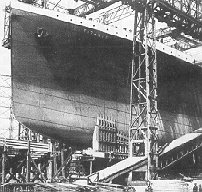R.M.S. TITANIC
Last month, Call Sign related the doomed adventure of Capt. Scott and
his Antarctic Expedition in March 1912. Staying in the Edwardian era,
Call Sign recalls the events of just one month later, when a marine
disaster claimed many lives and brought about a change in maritime
safety laws for the benefit of all.
Harland & Wolff in Belfast built the RMS Titanic for
the White Star Line. She was fitted out to the highest standards to
service the lucrative North Atlantic cruise trade and in a
prestige-grabbing policy, her Master, Capt. Edward Smith was
instructed to make best time on Titanic's maiden voyage.
Aboard the liner as she crossed the sea to New York, were
some of the richest and most influential people of the day. Locked
away in the bowels, travelling 'Steerage', were Irish emigrants hoping
for a better life in the New World. However, during the night of April
14, 1912, as Titanic sped gracefully through the calm but freezing
Atlantic waters, lookouts Fred Fleet and Reginald Lee scanned the
horizon for danger from their crow's nest high above the ship. Lacking
binoculars and only a bell and telephone to communicate with the
bridge, they shivered |
in the icy weather. Other shipping in the
vicinity had warned of icebergs, yet Titanic pushed on in haste...
Suddenly, at around 11.40pm, like a great white wall
drifting across the bows, an iceberg of quite mountainous proportions
appeared on the right side of the liner. Vital seconds were lost until
the helmsman on the bridge, responding to the lookout's cries and took
evasive action. As the big ship steered slowly away to the left, the
'berg tore a 300 ft gash in the hull. Although the incident lasted a
mere 10 seconds, the ship that was hailed 'unsinkable' was, in fact,
doomed.
Slowly, the forward compartments filled with water as the
ship began to list to the right. The lifeboats, of which there were far
too few for the number of passengers carried, were haphazardly launched
and frequently only half full. Distress flares were fired at regular
intervals but to no avail, despite at least one other ship being in the
area. Still believing the ship to be unsinkable, many passengers refused
to leave the stricken vessel. Those travelling in steerage found locked
gates that could have lead to safety, as the water rose ever higher.
Titanic was to sink in just under three hours, with the loss of nearly
fifteen hundred lives... |

Her distress calls, using the newly introduced international SOS
signal, was answered by Capt. Arthur Rostron aboard the 'Carpathia'
who arrived on scene at 4.10 am on 15 April 1912. His actions saved
many lives, picking up survivors till dawn.
The subsequent Board of Trade investigation determined that Capt.
Smith had ignored the ice warnings from other shipping, the ship had
been going too fast for the weather conditions and that the too few
life-boats had not been best utilized. Also, some passengers were
effectively imprisoned because of locked barriers preventing their
safe passage through the 'no-go' areas of First Class accommodation.
As a result of this enormous loss of life, maritime
safety practices were reviewed and many changes instituted to prevent
repetition of such a catastrophe re-occurring.
Alan Green
(c) Call Sign Magazine MM2 |